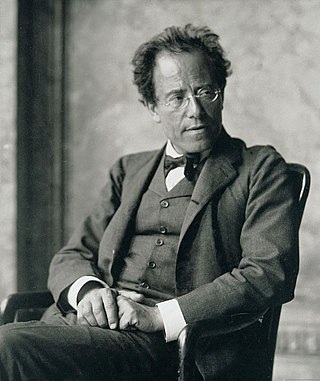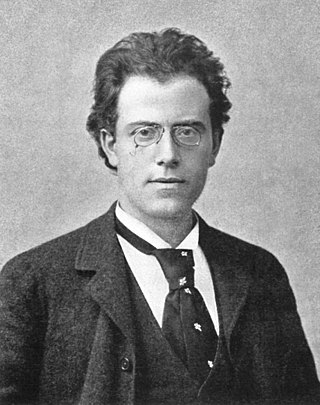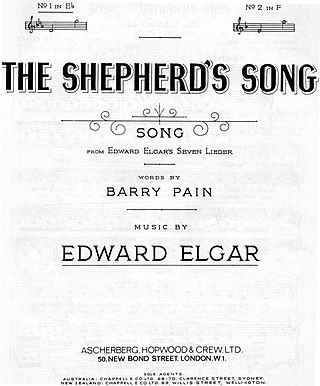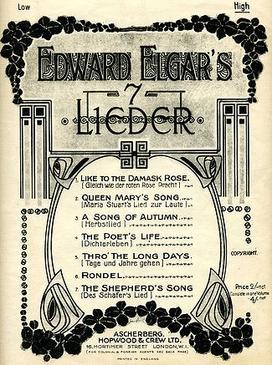Related Research Articles
The Pomp and Circumstance Marches, Op. 39, are a series of five marches for orchestra composed by Sir Edward Elgar. The first four were published between 1901 and 1907, when Elgar was in his forties; the fifth was published in 1930, a few years before his death; and a sixth, compiled posthumously from sketches, was published in 1956 and in 2005–2006. They include some of Elgar's best-known compositions.

Das Lied von der Erde is an orchestral song cycle for two voices and orchestra written by Gustav Mahler between 1908 and 1909. Described as a symphony when published, it comprises six songs for two singers who alternate movements. Mahler specified that the two singers should be a tenor and an alto, or else a tenor and a baritone if an alto is not available.

Lieder eines fahrenden Gesellen is a song cycle by Gustav Mahler on his own texts. The cycle of four lieder for medium voice was written around 1884–85 in the wake of Mahler's unhappy love for soprano Johanna Richter, whom he met as the conductor of the opera house in Kassel, Germany, and orchestrated and revised in the 1890s.
Sea Pictures, Op. 37 is a song cycle by Sir Edward Elgar consisting of five songs written by various poets. It was set for contralto and orchestra, though a distinct version for piano was often performed by Elgar. Many mezzo-sopranos have sung the piece.
"Der Doppelgänger" is one of the six songs from Franz Schubert's Schwanengesang that sets words by Heinrich Heine for piano and tenor voice. It was written in 1828, the year of Schubert's death.
"Jesu, Joy of Man's Desiring" is the popular English title of the chorale from the 1723 Advent cantata Herz und Mund und Tat und Leben, BWV 147, by Johann Sebastian Bach. The chorale occurs twice in the cantata, with different texts each time : as its sixth movement, Wohl mir, dass ich Jesum habe, and again as its tenth movement, Jesus bleibet meine Freude. The English title derives from famous piano transcriptions made by Myra Hess, in 1926 for piano solo and in 1934 for piano duet, as published by Oxford University Press. Whether played instrumentally or sung in German or English, the chorale is often heard at weddings and during Advent, Christmas, and Easter.

The Window; or, The Songs of the Wrens is a song cycle by Arthur Sullivan with words by Alfred, Lord Tennyson. Written in 1867–1870, it was eventually published in 1871. There are multiple versions of the title: On the cover of the 1871 edition, the subtitle is given as "The Loves of the Wrens", however, "Songs of the Wrens" is used on the frontispiece and is the one generally used.

25 Scottish Songs was composed by Ludwig van Beethoven. The work was published in London and Edinburgh in 1818, and in Berlin in 1822.
Twilight is a song with music by the English composer Edward Elgar written in 1910 as his Op. 59, No. 6. Elgar set the words of the poem The Twilight of Love, from Volume 2 of a series of poems called Embers by Sir Gilbert Parker. The Opus 59 songs were part of a song-cycle of six romantic songs by Parker that was never completed – Nos 1, 2 and 4 were never composed. The other songs were Oh, soft was the song and Was it some Golden Star?. The songs were originally written with piano accompaniment, but this was later re-scored by the composer for full orchestra.
Oh, soft was the song is a song with words by Gilbert Parker set to music by the English composer Edward Elgar in 1910, as his Op. 59, No. 3. It is the second and last verse of a poem At Sea which Parker published in Volume I of a series of poems called Embers. The Opus 59 songs were part of a song-cycle of six romantic songs by Parker that was never completed – Nos 1, 2 and 4 were never composed. The other songs were Was it some Golden Star? and Twilight. The songs were originally written with piano accompaniment, but this was later re-scored by the composer for full orchestra.
"A Song of Autumn" is a poem by Adam Lindsay Gordon set to music by Edward Elgar in 1892.

In the Dawn is a song written by the English composer Edward Elgar in 1901 as his Op.41, No.1.

Speak, Music! is a song written by the English composer Edward Elgar in 1901 as his Op.41, No.2.

”The Shepherd’s Song” is a song written by the English composer Edward Elgar in 1892. The words are by Barry Pain.
”Through the Long Days” is a song written by the English composer Edward Elgar in 1885 as No. 2 of his Op. 16, Three Songs. The words are from a poem by the American writer and statesman John Hay.

”Always and Everywhere” is a song by the English composer Edward Elgar with words translated from the Polish of Zygmunt Krasiński by Frank H. Fortey. It was composed and published in 1901.
”XTC” ("Ecstasy") is a song with words and music written by the English composer Edward Elgar in 1930. It was his last song, and written for the soprano Joan Elwes.

Seven Lieder is a set of songs by the English composer Edward Elgar published together in 1907, by Ascherberg, Hopwood & Crew Ltd.
Elisabeth Wintzer was a German composer and writer.
"Abendempfindung an Laura", K. 523, is a song by Wolfgang Amadeus Mozart dated June 24, 1787, in Vienna, written at the time of the opera Don Giovanni and Eine kleine Nachtmusik.
References
- ↑ Tennyson, Lord Alfred (1875). Queen Mary: a Drama. Boston: J. R. Osgood.
- ↑ Percy M. Young (1955). Elgar O. M. London: Collins OCLC 869820
- ↑ James Leonard. Songs & Piano Music by Edward Elgar at AllMusic
- ↑ https://web.archive.org/web/20081121200306/http://www.elgarfoundation.org/trolleyed/2/12/40/index.htm
- ↑ http://www.mvdaily.com/articles/2000/02/somm220.htm
- ↑ Incidental music to Queen Mary (Stanford) : Scores at the International Music Score Library Project
- ↑ "Queen Mary's Song" (Loder) : Scores at the International Music Score Library Project